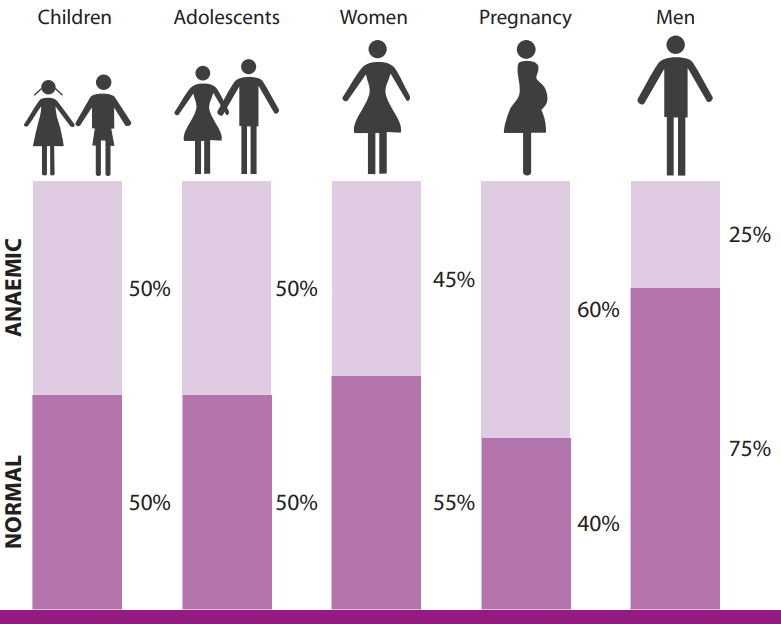
What is Anaemia?
Anaemia is a medical condition with below normal level of haemoglobin (Hb). Haemoglobin is the iron-containing
oxygen-transport metalloprotein in the red blood cells (RBCs). If you have anaemia, it means you have a reduced level Hb, the protein in your blood that carries oxygen.
A person who has anaemia is called anaemic. There are many types of anaemia, which are categorised according to their cause, which includes iron deficiency, vitamin B12 deficiency, folate deficiency and sickle cell disease.
How and Why Anaemia Occurs?
Blood is comprised of two parts – a liquid part called the plasma and a cellular part. The cellular part contains several different cell types.
RBCs are the most numerous cell types. The other cell types are the White Blood Cells (WBCs) and platelets. The haemoglobin molecule is the functional unit and a complex protein structure found in the RBCs.
RBCs are produced through a series of complex and specific steps. They are made in the bone marrow (inner part of some bones that make most of the cells in the blood), and when all the proper steps in their maturation are complete, they are released into the blood stream.
Erythropoietin secreted by kidneys and thyroxine hormone secreted by thyroid gland are essential for normal production of RBCs. Having the correct number of RBCs and prevention of anaemia requires proper functioning and synchronisation of the kidneys, bone marrow, and nutrients within the body.
Anaemia facts
- A healthy person has about five million red cells in every cubic millimetre of the blood. RBCs are produced in the marrow of large bones at the rate of about 2 million per second. Each cell contains Hb that carries oxygen through the body.
- Blood consists of 45% RBCs, less than 1% WBCs and platelets and about 55% plasma
- RBCs transport oxygen to the organ tissues in exchange for carbon dioxide, which is carried to and eliminated by the lungs
- In young children, marrow in all the bones produces RBCs. As a person ages, RBCs are eventually produced only in the marrow of the spine, ribs and pelvis
- Old RBCs are removed from the blood by the liver and spleen, and the iron extracted is returned to the bone marrow to make new cells
- The body needs iron,vitamin B12 and folic acid (one of the B group of vitamins) to produce more RBCs. Lack of one or more of these nutrients leads to anaemia. Iron deficiency anaemia is the most common type of anaemia
Grading of Anaemia
Grade 1 – Mild Anaemia (10 g/dl)
Grade 2 – Moderate Anaemia (7-10 g/dl)
Grade 3 – Severe Anaemia (Below 7 g/dl)
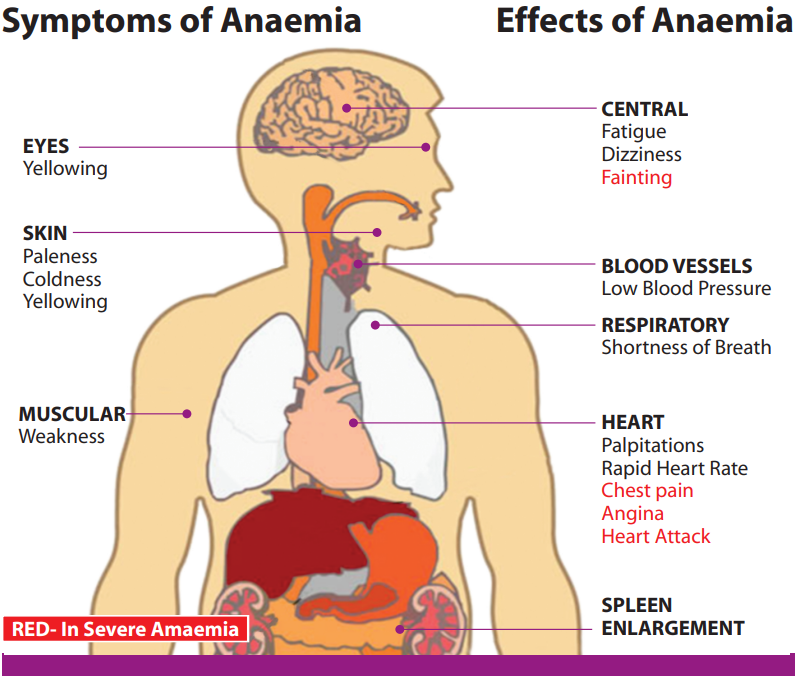
The doctor makes a diagnosis from the medical history, physical examination and blood tests. A specialist (haematologist) may be involved if causes are not clear. In some cases, a test known as a bone marrow exam may be done to determine the underlying cause of the anaemia.
Managing Anaemia
Anaemia is actually a sign of a disease process rather than a disease itself. Hence careful search for actual cause is very important.
Blood tests help in confirming the diagnosis of anaemia, and also aid in identifying the underlying condition. The tests might include complete blood count (CBC), blood iron, serum ferritin, vitamin B12 and folate levels, reticulocyte count, bilirubin, and other blood and urine tests as required.
Treatment depends on the cause and severity of the disease. Blood transfusions may be required for severe anaemia. For iron
deficiency anaemia, the doctor may prescribe iron tablets. For pernicious anaemia, vitamin B12 injections are given, usually for life.
However, the main treatment of anaemia due to any chronic disease is the right management of the underlying pathology. For instance, erythropoietin given as injections, may be used in severe anaemia caused by renal failure or cancer.
Dietary modifications with iron or vitamin B12 rich food are essential part of the treatment in anaemia. As anaemia develops when body is completely depleted of all reserve iron, it is very important to take supplement for 2-3 months after normalisation of haemoglobin to restore these stores in the body
Iron is essential for
- The formation of haemoglobin and certain enzymes
- Many proteins and enzymes that maintain good health
- Transporting oxygen in the blood to all parts of the body
- Many metabolic reactions and the regulation of cell growth and differentiation
- Immune activity
- Proper functioning of the liver
- Protecting the body against the actions of free radicals
Causes
- Lack of iron, folate and vitamin B12 due to poor diet or poor absorption from the intestines
- Hereditary diseases (e.g., sickle cell anaemia) that can cause destruction of the RBCs
- Autoimmune diseases where the body attacks its own RBCs and destroys them
- Blood loss from bleeding stomach ulcers, gastritis, colon cancer or heavy periods
- Alcoholics can have folate deficiency, that is mainly caused due to poor diet
- Any chronic disease lasting for more than one or two months
Factors Causing Anaemia

People at risk
- Infants and Children
- Premenopausal Women
- Older Adults
- Alcoholism
- Iron-Deficient Diets
- Chronic or Critical Illnesses
- Excessive Exercise
- Pregnancy
- Frequent Blood Donors
Iron rich recipes
Nuti – bhajiya
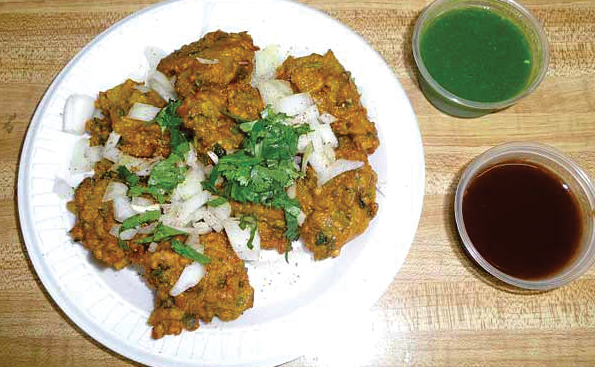
Serves: 5
Cooking Time: Under 15 minutes
Ingredients
- Cauliflower Leaves -100g
- Besan (Bengal Gram) – 1 cup (100 g)
- Rice Flour – ¼ cup ( 25 g)
- Wheat Flour – ¼ cup ( 25 g)
- Tamarind Juice – 1 tsp
- Chilly Powder – ½ tsp
- Jeera (Cumin Powder) – ¼ tsp
- Ajwain (Bishop’s Weed) – ¼ tsp
- Oil for frying
- Salt to taste
Method
- Wash and pat dry 12-15 medium cauliflower leaves. It is important that they are totally dry.
- Heat the oil for frying.
- Whisk together in a bowl – 2 cups chickpea/ flour (besan), ¼ cup rice flour, ¼ cup of wheat flour, ¼ tsp each chilly powder, ¼ tea spoon of cumin powder, ¼ tsp ajwain (bishop’s weed) and salt. Add the tamarind juice and sufficient water to make a batter thick enough to coat the leaves completely without sliding off (like pancake batter). Taste it to make sure it’s well-seasoned.
- When the oil is hot, dip the whole cauliflower leaf in the batter, make sure it’s completely coated, and slide it in the oil carefully.
- Fry them until they are golden brown, turning them over once. Drain in a paper-towel lined plate. Let it sit on the plate for 2-3 minutes, to drain and firm up a bit.
- Serve them hot with green coriander chutney.
Nutritive value – PER SERVING
Energy: 879 kcal
Protein: 31.43 g
Carbohydrate: 104.3 g
Fat: 37.44 g
Iron: 45.99 mg
Veg cocktail
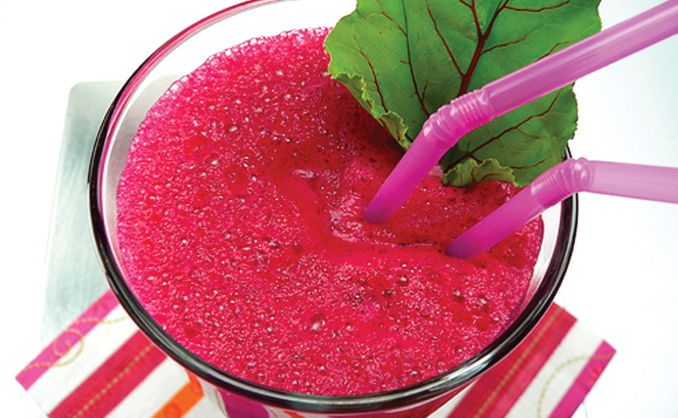
Serves: 2
Cooking Time: Under 10 minutes
Ingredients
- Beetroot – ½ small size (50 g)
- Watermelon – 1 ½ cup (200 g)
- Lime – 1 small size
- Guava – 1 ( 100 g)
- Mint Leaves – 1 tbsp
- Sugar Powdered – 1 tbsp
- Water – 1 cup (as required)
- Crushed Ice
Method
- Peel beet and guava, chop them into small pieces,and place them in a blender.
- Squeeze the juice from the lime into the blender.
- Wash, de-seed and chop the watermelon, and place the pieces in the blender.
- Wash and chop the mint leaves, and place them in the blender.
- Add 1 tbsp of powdered sugar in the blender, along with 1 cup of water
- Run the blender till you get the desired consistency. You can also use the same ingredients in a juicer.
- Garnish with mint leaves. Serve chilled with crushed ice.
“The juice has to be consumed within an hour or so after preparation to ensure you get all the nutrients. It’s a good recipe for those prone to anaemia because beet juice & watermelon are good sources of iron, and guava and lime are rich in vitamin C, which is the catalyst that helps the body absorb iron from non-heme sources.” – Vidisha Parekh, Dietitian-RD, Kokilaben Dhirubhai Ambani Hospital.
Nutritive value – PER SERVING
Energy: 151 kcal
Protein: 1.35 g
Carbohydrate: 35 g
Fat: 0.65 g
Iron: 17.59 mg
Enhance iron absorption
- Separate tea drinking from mealtime
- Tea, one or two hours after meal, will not inhibit iron absorption as most of the food would have left the stomach
- Have fruit juices,such as orange juice, or other source of ascorbic acid, such as tubers,cabbage,carrots or cauliflower
- Include adequate portions of meat, poultry, fish and seafood in your diet
- Consume milk, cheese and other dairy products as a between-meal snack, rather than at mealtime
Iron Rich Food
Meat, Egg Yolk, Fish like Tuna & Salmon, Oysters, Grains, Beans, Lentils, Chick Peas, Soyabeans, Nuts, Dry Fruits like Raisins & Dates, Dark Leafy Vegetables like Spinach Carrots, and Fresh Fruits.
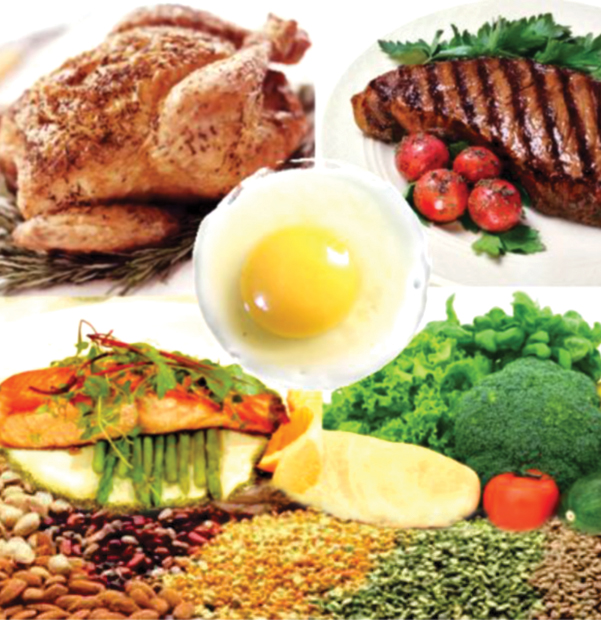
Iron intake references
Infants and Children:
0-6 months – 0.27 (mg/day)
7-12 months – 11 (mg/day)
1-8 years – 7-10 (mg/day)
Males:
9-18 years – 11 (mg/day)
19+ years – 8 (mg/day)
Females:
9-18 years – 15 (mg/day)
19-50 years – 18 (mg/day)
51+ years – 8 (mg/day)
Pregnancy: 27 (mg/day)
Lactation: 9-10 (mg/day)
Our Multi-Specialist Team
Dr. Niranjan Rathod, Dr. Nidhi Mehta, Dr. Pankhi Durra and Ms. Vidisha Parekh (Dietitian)
 Back to Site
Back to Site